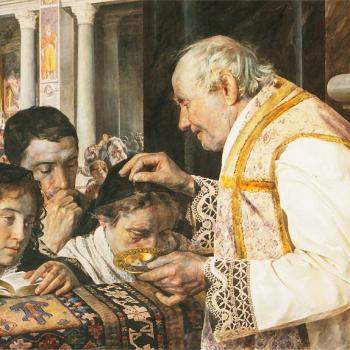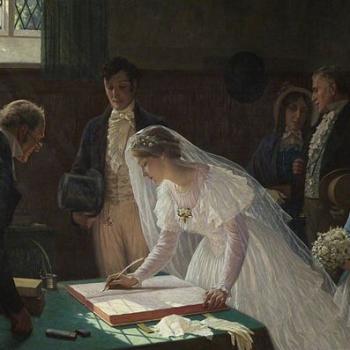Wikipedia is a useful but occasionally time wasting tool. Go on line to check the birth date of a 19th century German author and two hours later you find yourself reading about Chinese pottery, Greek mythology, or West Ham United. A few days ago I went on to check something (I truthfully no longer remember what) and ended up reading about Emo. For those who have managed to miss this trend, it is a musical style “characterized by melodic musicianship and expressive, often confessional lyrics.” It originated in the 1980’s as part of the punk scene, but it has evolved away from it. Emo is short for emotional, and the music often conveys feelings of angst or despair. It embraced by a subculture of teenagers, mostly marginal within the dominant hierarchies of high school. It is hard to give a comprehensive characterization of them, but one common description is that emos
appear depressed, have black or red hair, and dress in a way that is contrary to what is popular. Thrift stores, art, coffee shops, underground music, and poetry are usually of great interest.
Now I must confess that I don’t listen to much emo, or at least I don’t think I do. I know a smattering of band names, and there are a few songs that I think of as emo. One of these is the song Iris by the Goo Goo dolls:
Now as I was writing this I asked my 15 year old son who informed me categorically that this song is NOT emo. On the other hand, a quick search on line showed that this is a matter of dispute, with a lot of people asserting that it is. It is even quoted on the So Emo website in England. One reason I associated it with emo (and apparently so do a number of other people) are the angst filled lyrics. One stanza in particular caught my attention the first time I heard it, and it is one reason that I come back to this song on a regular basis:
When everything feels like the movies, yeah you bleed just to know you’re alive.
This feeling of disaffection and disassociation seems to me to speak volumes about the emptiness of much of modern culture. (There is also a personal connection, but I’ll come back to that at the end.) Now emo is not the first musical genre that expresses these feelings. Forty years ago, The Who touched on many of the same emotions (or lack thereof) in their song Behind Blue Eyes:
http://www.youtube.com/watch?v=BfuWXRZe9yAOn the other hand The Who, in their lyrics both for this song and their other work, had an outward directed anger that is missing from Iris, which seems much more inward focused.
Precisely for this reason I have associated this song with “cutting”: an act of self-mutilation that involves making a number of shallow cuts with a knife or razor blade, often on the arms or torso. Cutting has become closely associated with the emo scene. The reason is hotly contested. Cutting is regarded by mental health professionals as a manifestation of self harm, a kind of depression. Some people argue that there is no real connection: some people who suffer from mental illness get drawn to the emo scene, and their behavior got picked up by the media. Others argue that angst filled teenagers pick up on it and find in it a cathartic release. What is certain is that a search for “cutting” and “emo” will produce a lot of sites filled with graphic and disturbing images posted by people who describe themselves as emos.
Whatever the connection, it has inspired a movement to connect people suffering from depression who are emo (or part of the broader emo scene) to get help. Speaking directly to the act of cutting, they call themselves To Write Love on Her Arms.
Now on the one hand, this is quite abstract and distant: in my middle age I am well beyond the world weary angst of my youth, which found expression in Romantic era poetry and reveled in a rather overblown sense of pathos a la Childe Harold’s Pilgrimage. But even back then I find it hard to imagine that I would have ever cut myself, to “bleed just to know you’re alive.” There was simply no place in the milieu in which I grew up for this kind of behavior.
On the other hand, there was a way to accomplish the same ends (doing violence to oneself as a cover or release for emotional pain) which was culturally acceptable: the bar fight. It was an “approved” way of dealing with loss and depression. You went out, drank way too much, and picked a fight with anybody who was willing to fight back. You got beaten bloody (whether you win or lose) and woke up the next morning hung over and in pain. It was (and is) kind of a stupid way of dealing with emotional issues, but it happened and it had enough macho overtones that it made it understandable to guys of my age and social class.
I only came close to doing this once. My girlfriend, after a very rocky relationship had dumped me for the second time in two months. I was tired, stressed out by school, and hated her, myself and life in general. My solution: go out and get really drunk. As I was leaving the dorm I ran into my friend Mic sitting with his girlfriend. He caught the expression on my face, stopped me and demanded to know what was going on. I explained what had happened and my plans. His reaction was immediate: he got completely serious, looked me in the eye and said, “Promise me: no fights.” His girlfriend started laughing, but he curtly cut her off and repeated this demand. He would not let me leave until I promised not to start any fights. I kept my word: I sat in a corner of the bar and drank too much, and spent the night in my bathroom throwing up.
Despite this rough spot, this story does have a happy ending: eventually my girlfriend and I got back together, and next September we celebrate our 26th anniversary. Mic was my best man at the wedding. But as I contemplate the connection between the drunken angst of my youth and the self-mutilation of teenagers today, I wonder: what other forms of self-destructive behavior of this kind are going on around me that we do not see—or at least that I do not see? And what outlets can we provide, as a Church and community, for the pain and angst that underlie these acts? I recall hearing the mantra “talk to someone” when I was younger, but talking requires not only someone to talk to, but a vocabulary, a basis for communication. Thinking back, I don’t think I had anyone who I could talk to who would grasp what I was trying to say. This sounds like a common teenage complaint: “No one understands me!” but I think there is some truth to this. The romantic poets and rock lyrics spoke to me, but they did not give me an emotional vocabulary for expressing what was really bothering me.
Moreover, there were many cultural obstacles to this kind of self-expression. Guys had to be “tough”; being “sensitive” was a serious put down: worse, since it often came with the implication that you were gay. I think many of the same barriers exist today. Getting back to emos, a great deal of the abuse heaped on them is precisely because they are “getting in touch with their emotions.” So the next time you see a kid with dyed hair, a bit too much make up and an affected air of moodiness, think about what they are trying to say, and how you can help build a community in which it is okay to speak it.
This post goes out to my old friend Mic K. who did right by me when I needed it.












